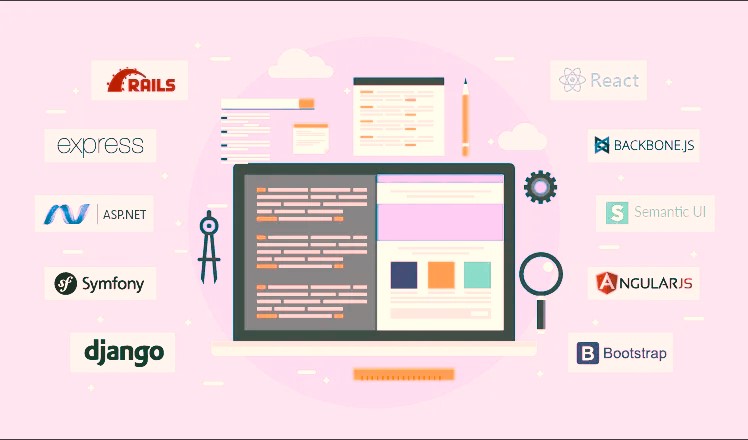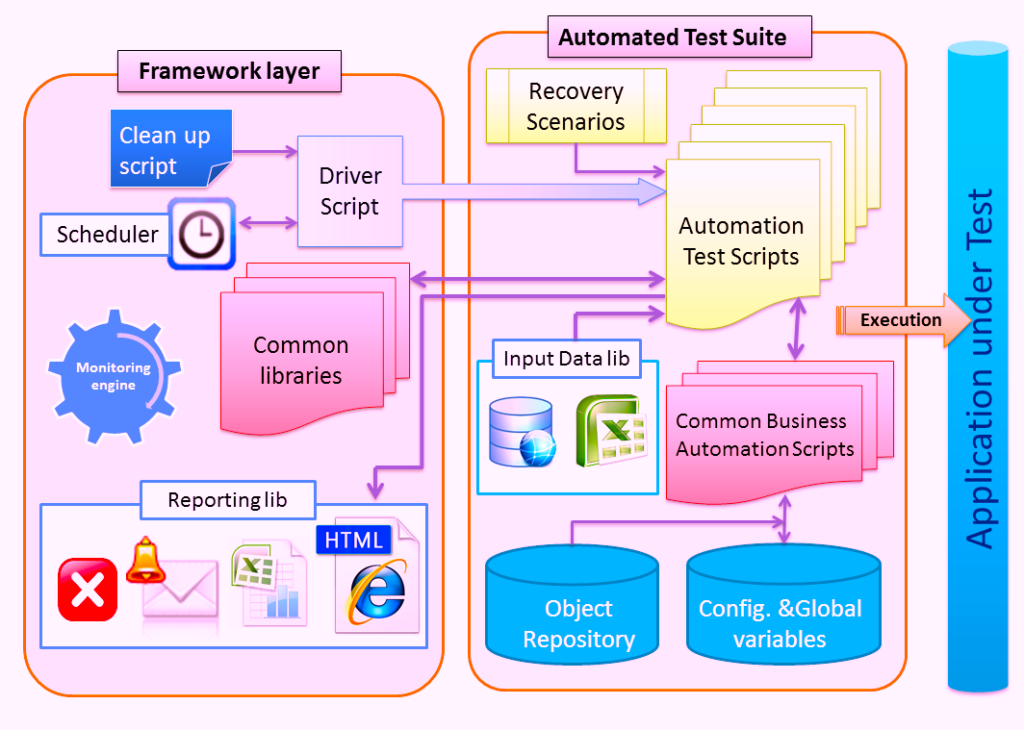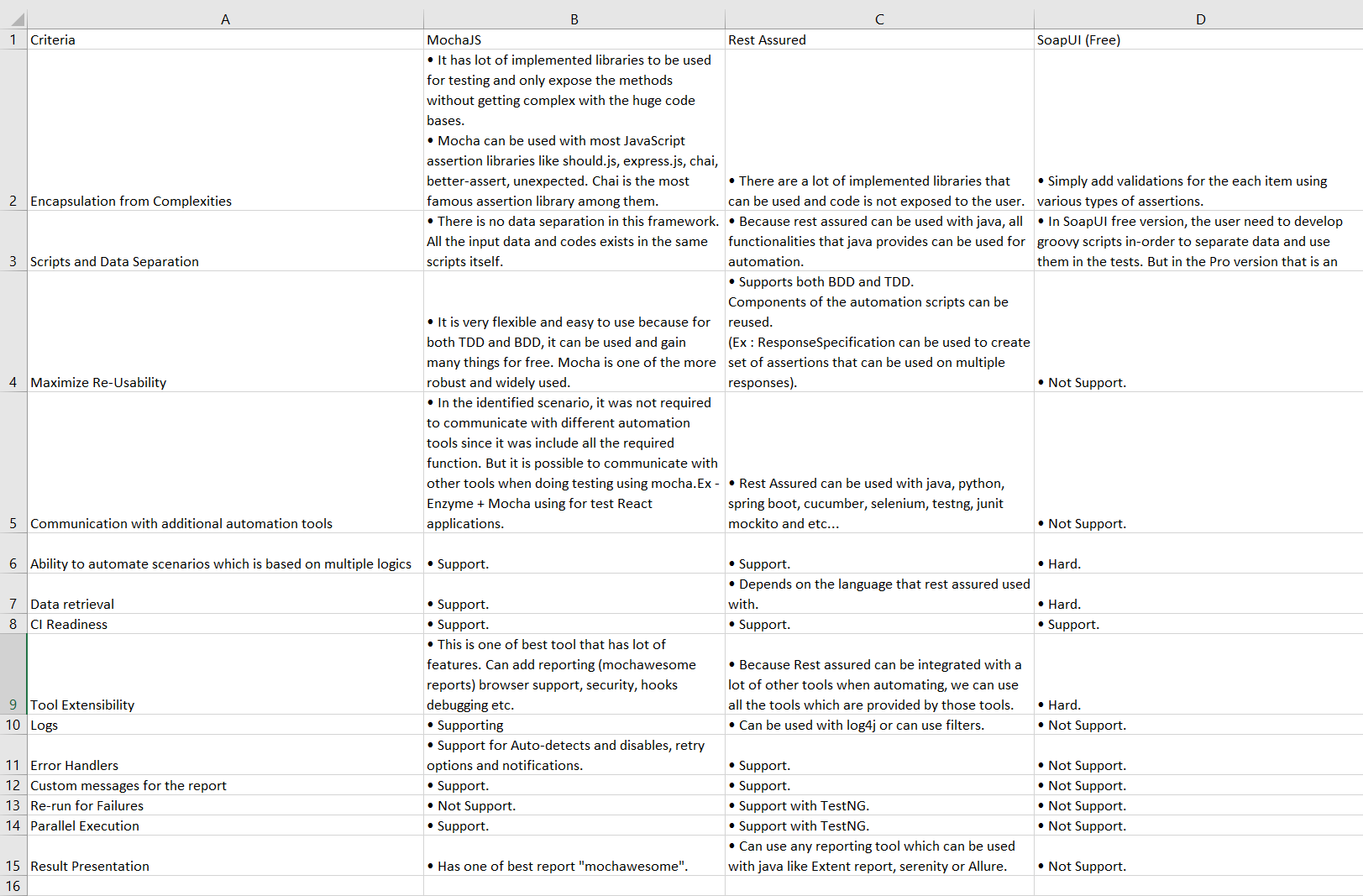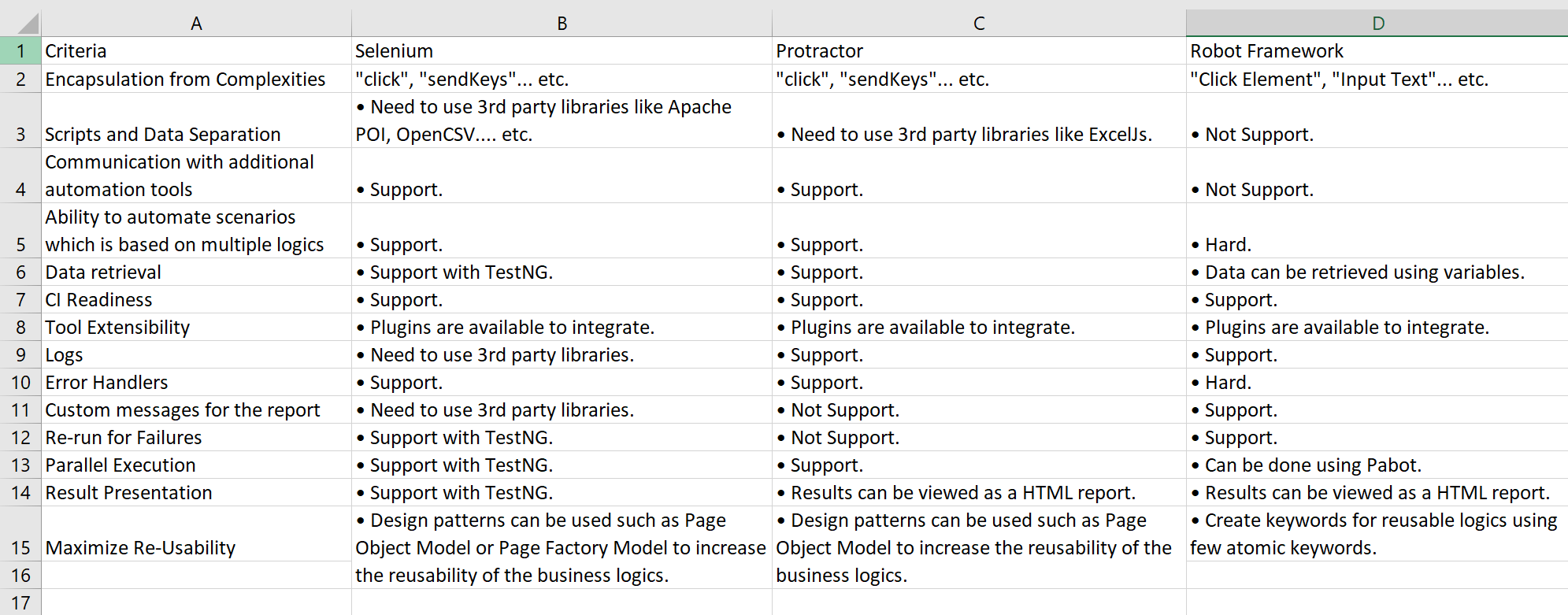
Test automation framework evaluation criteria
What is a Framework?
A framework, in the context of software development, refers to a structured and reusable set of tools, libraries, and conventions that provide a foundation for building applications. It offers a pre-defined structure and a collection of functions and modules that developers can utilize to streamline the development process and address common programming tasks.
Frameworks typically include various components, such as libraries, compilers, APIs (Application Programming Interfaces), and runtime environments. They provide a structured way to develop applications by enforcing specific programming paradigms, design patterns, and best practices. Frameworks can be used for different types of software development, including web development, mobile app development, desktop application development, and more.
The main purpose of a framework is to provide developers with a standardized and efficient way to create applications, eliminating the need to reinvent the wheel for common functionalities. By leveraging a framework, developers can focus more on the unique aspects of their applications rather than dealing with low-level details.
What is a Test Automation Framework?

A test automation framework is a set of guidelines, practices, and tools that provide a structured approach to automate the testing of software applications. It offers a systematic and reusable framework for designing, implementing, and executing automated tests.
Test automation frameworks aim to simplify the process of creating and maintaining automated tests by providing a consistent structure and a collection of utilities and functionalities. They help in managing test data, handling test execution, generating test reports, and promoting code reusability.
Here are some key components typically found in a test automation framework:
- Test Scripting: Frameworks provide a way to create test scripts or test cases using programming languages or specific scripting languages. These scripts define the steps to be executed during test automation.
- Test Data Management: Frameworks assist in managing test data, such as input values, expected outputs, and test configurations. They may include mechanisms for data-driven testing or provide integration with external data sources like databases or spreadsheets.
- Test Execution: Frameworks offer mechanisms to execute automated tests, including handling test setup and teardown, managing test dependencies, and providing an execution environment.
- Reporting and Logging: Frameworks often provide built-in reporting and logging capabilities to capture test results, errors, and other relevant information. This helps in analyzing test outcomes and identifying issues.
- Test Environment Management: Frameworks may include features to manage test environments, such as setting up and tearing down the necessary infrastructure, configuring test systems, and handling dependencies on external resources.
- Test Maintenance and Extensibility: A good test automation framework should facilitate test maintenance and extensibility. It should be easy to update or modify test scripts, add new tests, and integrate with other tools or frameworks.
- Integration with Testing Tools: Frameworks often integrate with testing tools and libraries to enhance their capabilities. These tools can include test runners, assertion libraries, code coverage tools, and continuous integration/continuous delivery (CI/CD) systems.
There are various test automation frameworks available, catering to different programming languages, application types, and testing requirements. Some popular frameworks include Selenium (for web application testing), Appium (for mobile app testing), Robot Framework (a generic framework supporting multiple testing types), and JUnit/TestNG (for unit testing in Java), among others.
By adopting a test automation framework, organizations can standardize their testing processes, improve test efficiency, achieve better test coverage, and increase the reliability and maintainability of their automated test suites.
Advantages of a Test Automation Framework
Implementing a test automation framework offers several advantages for software testing and quality assurance processes. Here are some key benefits:
- Reusability: A well-designed test automation framework promotes code reusability. By providing reusable components, libraries, and utilities, it allows testers to write test scripts that can be easily reused across multiple test cases or projects. This saves time and effort in test creation and maintenance.
- Scalability: Test automation frameworks facilitate scalability by providing a structured approach to test development. As the application under test evolves and grows, the framework allows testers to easily add new tests or modify existing ones without significant overhead. This ensures that automated tests can keep up with the pace of application development.
- Maintainability: A framework enhances test maintenance by enforcing standards and best practices. It provides a clear structure and guidelines for organizing tests, handling test data, and managing test execution. This makes it easier to update or modify tests as requirements change, reducing the effort required for test maintenance.
- Consistency and Standardization: Frameworks promote consistency and standardization across automated tests. By providing predefined templates, coding conventions, and guidelines, they ensure that all tests follow a unified approach. This makes the tests more readable, understandable, and maintainable by different team members, improving collaboration and reducing the learning curve.
- Test Reporting and Analysis: Test automation frameworks often include built-in reporting and logging capabilities. They generate comprehensive test reports with detailed information on test execution results, including passed and failed tests, error messages, and screenshots. This allows testers and stakeholders to analyze test outcomes, identify issues, and make data-driven decisions for quality improvement.
- Integration with Tools and Environments: Frameworks can integrate with various testing tools, libraries, and environments. They provide adapters or plugins to seamlessly connect with tools for test management, version control, continuous integration, and defect tracking. This integration streamlines the testing workflow, enhances productivity, and supports the overall software development lifecycle.
- Faster Time-to-Market: Test automation frameworks contribute to faster time-to-market by accelerating the testing process. Automated tests can be executed more quickly and frequently compared to manual testing, allowing faster feedback on the application’s stability and quality. This enables faster identification and resolution of defects, leading to shorter release cycles and quicker product delivery.
- Improved Test Coverage: With test automation frameworks, it becomes feasible to achieve higher test coverage. Automated tests can cover a wide range of scenarios, including edge cases, negative cases, and regression tests, ensuring that critical functionalities are thoroughly validated. This reduces the risk of undiscovered defects and improves overall software quality.
Overall, a well-designed test automation framework brings efficiency, reliability, and maintainability to the testing process. It enables organizations to achieve higher productivity, better test coverage, and faster feedback, ultimately leading to improved software quality and customer satisfaction.
Key points to think before select a Test Automation Framework
When selecting a test automation framework, there are several key points to consider. Here are some important factors to think about:
- Application Type and Technology: Consider the type of application you are testing (web, mobile, desktop) and the technology stack involved (Java, .NET, Python, etc.). Ensure that the chosen framework supports the application type and has the necessary capabilities and integrations for testing the technology stack.
- Test Requirements: Evaluate your specific testing requirements and determine if the framework aligns with them. Consider factors such as test types (functional, regression, performance, etc.), test data management, test environment management, and support for specific testing techniques (data-driven testing, keyword-driven testing, etc.).
- Ease of Use and Learning Curve: Assess the framework’s ease of use and the learning curve for your team. Consider whether the framework offers clear documentation, tutorials, and community support. A framework with a gentle learning curve can expedite the adoption process and minimize training efforts.
- Integration with Tools and Ecosystem: Determine if the framework integrates smoothly with other tools and testing ecosystem components. Look for compatibility with test runners, reporting tools, CI/CD systems, version control systems, and defect tracking tools. Integration capabilities can enhance automation workflows and streamline collaboration.
- Community and Support: Evaluate the community around the framework. A vibrant community provides access to forums, user groups, and resources for troubleshooting, sharing knowledge, and staying updated with the latest developments. Robust community support can be invaluable in addressing challenges and finding solutions.
- Scalability and Maintainability: Consider the framework’s scalability and maintainability. Assess if it supports the growth of test suites and the ease of adding, modifying, and maintaining test scripts. A scalable and maintainable framework will ensure long-term sustainability as the application and testing needs evolve.
- Reporting and Test Management: Check the framework’s reporting capabilities. Ensure it provides clear and comprehensive test reports that facilitate analysis and decision-making. Additionally, assess if the framework supports test management features such as test case management, test prioritization, and test scheduling.
- Flexibility and Extensibility: Determine if the framework allows customization and extension to meet specific requirements. A flexible framework enables you to tailor it to your testing needs and integrate custom libraries or tools. Extensibility ensures that the framework can adapt to future changes and accommodate emerging technologies.
- Community Feedback and Adoption: Research the reputation and adoption of the framework within the testing community. Look for feedback and experiences shared by other users to gain insights into the framework’s strengths, weaknesses, and overall reliability. Consider frameworks with a positive track record and wide adoption.
- Cost and Licensing: Consider the cost implications and licensing terms associated with the framework. Determine if it aligns with your budget and licensing requirements. Some frameworks may be open-source, while others might have commercial licenses or offer enterprise versions with additional features and support.
By carefully considering these factors, you can make an informed decision when selecting a test automation framework that best fits your testing requirements, team skills, and long-term goals.
1. Comparison of Web UI Automation Frameworks

2. Comparison of API Automation Frameworks



